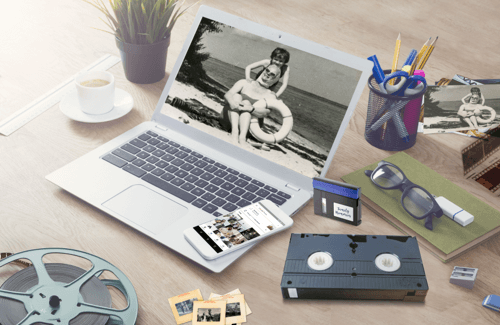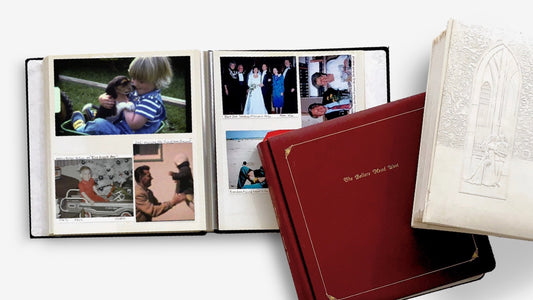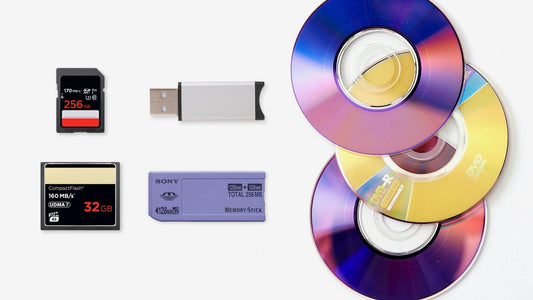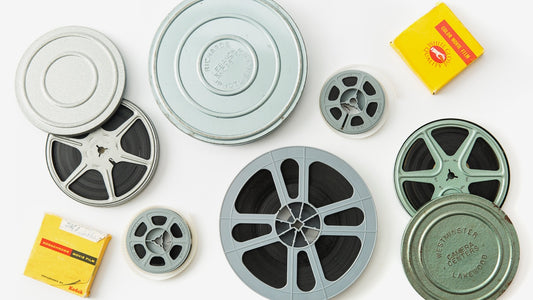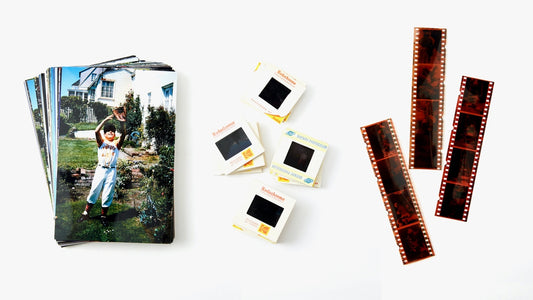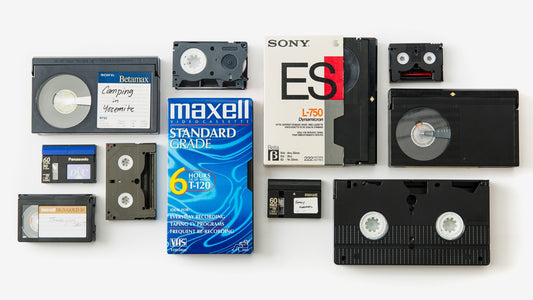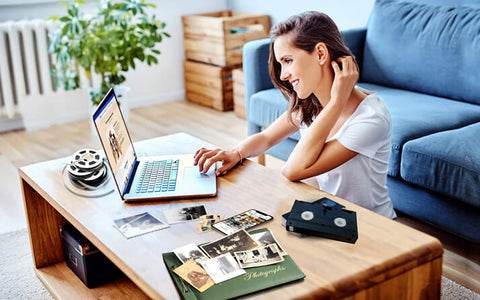The moments captured on 35mm slides are more than just pictures; they are a direct link to your family’s history. They show the faces of relatives younger generations have never met and tell stories from a time before digital everything. But for your children or grandchildren, a slide is an ancient artifact. The best way to share this legacy is to make it accessible. When you scan 35mm slides, you’re not just converting images—you’re building a bridge between the past and the future. You’re creating a digital archive that your entire family can easily view, share, and cherish on any modern device, anywhere in the world.
Key Takeaways
- Digitize Your Slides to Preserve Them Forever: Physical slides degrade over time, but creating a digital copy stops the fading and damage, ensuring your family's memories are safe and easy to share for generations to come.
- Choose Between a Professional Service and DIY: A professional service is your best bet for high-quality results and saving time, especially with large collections. A DIY project offers more control but requires a significant investment in equipment and patience.
- Organize and Back Up Your Digital Photos: Once your slides are scanned, create a simple folder system and use a reliable backup strategy to protect your new digital archive from being lost.
What Are 35mm Slides and Why Should You Digitize Them?
If you’ve ever stumbled upon a box of old family slides, you know they’re like tiny, vibrant windows to the past. A 35mm slide is a small, transparent photograph, usually housed in a cardboard or plastic mount, designed to be viewed with a projector. For decades, this was how families captured and shared their most cherished moments—from birthday parties and vacations to weddings and holidays. Each slide holds a story, a flash of color and light from a time before smartphones and digital cameras.
But these physical memories are fragile. They can fade, get scratched, or be lost to time, dust, or moisture. That’s where digitization comes in. Converting your slides into digital files is the best way to preserve them for future generations. It allows you to easily view, share, and enjoy these moments on any modern device, ensuring they won’t be forgotten in a dusty box in the attic. Think of it as rescuing your family’s history and bringing it into the present.
Identify Your Slide Types
Before you begin any scanning project, it helps to know what you’re working with. Not all 35mm slides are created equal. You’ll likely find slides from different brands, and each has its own unique look. Popular film stocks like Kodachrome, Ektachrome, and Fujichrome all have distinct color profiles. Kodachrome, for example, is famous for its rich, archival quality, while Ektachrome is known for its vibrant saturation. Recognizing these differences can help you understand why some slides might have a warmer or cooler tone, which is useful information whether you decide to scan them yourself or use a professional service.
The Importance of Going Digital
Slides from the pre-digital era are precious, but they’re also vulnerable. Over time, the dyes in the film can fade and shift, causing colors to look washed out or unnatural. They’re also susceptible to physical damage like scratches, dust, and even mold if not stored properly. Digitizing your slides is the single best way to stop this decay in its tracks. By creating a high-quality digital copy, you’re essentially freezing that memory in time. A digital file won’t fade or get scratched, and you can create endless backups. This makes a photo transfer an essential step in preserving your family’s legacy.
Check Your Slides for Common Issues
Take a close look at your slides before you start scanning. Decades of storage can take a toll, and you’ll want to spot any issues ahead of time. Look for dust, fingerprints, and fine scratches on the surface of the film. In some cases, you might even see signs of mold or water damage if the slides were stored in a damp environment. The colors may have also faded or shifted, giving photos a reddish or bluish tint. Addressing these issues by carefully cleaning the slides and preparing for color correction is a crucial first step, especially if you’re planning a DIY project.
How Do Professional Slide Scanning Services Work?
If the idea of tackling a mountain of slides feels overwhelming, you're not alone. Handing your memories over to a professional service can be a huge relief. Instead of buying equipment and spending hours at a scanner, you can let experts handle the entire process for you. Professional services are built to manage this work efficiently, using high-end equipment and refined techniques to get the best possible quality from your old slides. They take on the technical challenges so you can focus on the fun part: reliving your favorite moments.
The Professional Scanning Process
When you work with a professional service, the process is designed to be simple and secure. You’ll typically start by placing an order online and receiving a special, crush-proof box to safely mail your slides. Once your collection arrives at the facility, trained technicians carefully clean and prepare each slide by hand. They then use professional-grade scanners to capture every detail. After digitizing, your original slides are returned to you along with your new digital copies, which are usually available on a DVD, USB drive, or through a secure cloud link. A service like YesVideo's photo transfer can handle the entire process for you, ensuring high-quality scans and peace of mind.
What to Expect: Quality and Equipment
The biggest advantage of going pro is the quality. Professionals use dedicated, high-resolution scanners that are far more powerful than consumer-grade models. These machines capture images at a high DPI (dots per inch), which means your digital photos will be crisp, clear, and large enough to print without looking pixelated. Technicians also perform manual color correction and scratch reduction to restore your images to their original vibrancy. Understanding these key quality markers will help you spot the difference between a quick scan and a professional, archival-quality transfer that truly does your memories justice.
A Look at YesVideo's Technology
We take the process a step further with technology designed specifically for family memories. For example, if your slides are still in carousels or you have entire photo albums you want to preserve, our album scanning service can digitize pages without you needing to remove each photo. This is fantastic for keeping the original layout and any handwritten notes, which preserves the context and story behind the pictures. We also use patented technology to remove glare and correct colors during the scanning process, making your images look their best right away. It’s all done by hand, right here in the USA, by technicians who care about your memories as much as you do.
Understanding Pricing and Service Options
Pricing for slide scanning is usually based on the number of slides you have, with costs calculated on a per-slide basis. Many services offer tiered pricing, so the more slides you send in, the lower the per-slide cost becomes. When comparing options, look at what’s included in the price. Does it cover cleaning, color correction, and digital delivery? Some services might charge extra for higher resolutions or for saving your files on a USB drive. It’s always a good idea to get a clear quote upfront so you know exactly what to expect and can choose the service that best fits your budget and needs.
What to Look for in a Slide Scanning Service
Choosing a slide scanning service feels like a big decision—after all, you’re trusting someone with irreplaceable family memories. While many companies offer this service, the quality and care can vary quite a bit. To make sure you get the best possible digital versions of your slides, it helps to know what to look for. From the technical specs like image resolution to the special touches like dust removal, a few key features can make all the difference. Let’s walk through the most important things to consider so you can choose a service with confidence.
Resolution: Why It's Key for Image Quality
Resolution is one of the most important factors for image quality, and it’s measured in DPI, or dots per inch. Think of it like the pixels in a modern digital photo—the more you have, the clearer and more detailed the image will be. A standard scan is often around 2,000 DPI, which gives you a decent digital picture. For truly stunning results, look for a service that offers 4,000 DPI. This higher resolution captures the fine details in your slides, creating images that look sharp even when you zoom in or print them. This is especially important for preserving the rich quality of your original photo transfers.
Say Goodbye to Dust and Scratches
Over the years, 35mm slides can collect dust, fingerprints, and tiny scratches, even when stored carefully. These imperfections can really stand out once they’re digitized. That’s why a top-tier scanning service will include manual cleaning and digital correction as part of their process. Many professionals use advanced technology, like Digital ICE, which automatically detects and removes dust and minor scratches from the image during the scan. This digital restoration can dramatically improve the final look, giving you clean, vibrant photos that look as good as the day they were taken. It’s a feature that saves you hours of manual photo editing later on.
How Speed and Automation Help
If you have a big collection of slides, the thought of scanning them one by one can be overwhelming. This is where professional services have a huge advantage. They use specialized, automated equipment designed to handle large batches of slides quickly and consistently. This doesn’t mean they cut corners; this high-end machinery is paired with powerful software and expert technicians who oversee the process. This efficiency means you get your digitized memories back much faster than you could with a DIY setup. A professional film transfer process ensures every slide is handled with care while still delivering a speedy turnaround.
Ensure Your Scans Are Compatible
Once your slides are scanned, you’ll want to be able to easily view, share, and edit them. Before committing to a service, check what kind of files they provide. Most services deliver images as JPEGs, which are universally compatible with any computer, tablet, or smartphone. This makes it simple to upload them to social media or send them to family. Also, consider how you’ll receive your files. Reputable companies offer flexible options, like a secure cloud download, a USB drive, or DVDs. Make sure the delivery method works for you and your technical comfort level so you can access your memories without any hassle.
Want to Scan Slides Yourself? A Step-by-Step Guide
If you love a good project and have the time to spare, scanning your own 35mm slides can be a rewarding experience. It gives you complete control over the process, from choosing the equipment to making final edits. It’s a chance to reconnect with each memory as it appears on your screen, reliving family vacations and childhood milestones one image at a time. Taking on this project yourself means you can work at your own pace and tailor the digital results to your exact preferences.
However, it’s important to go in with a clear understanding of what the process entails. Digitizing slides requires patience, a bit of technical know-how, and the right equipment to get high-quality results. You’ll be responsible for everything from cleaning each individual slide to color-correcting the final digital files. For a small collection, this can be a fun weekend activity. But if you have boxes filled with hundreds or even thousands of slides, the time commitment can quickly become overwhelming. This guide will walk you through the entire process, helping you decide if DIY is the right path for you and giving you the steps to do it right.
How to Choose the Right Scanner
The most important decision you'll make is which scanner to use, as it directly impacts the quality of your digital images. Start by thinking about your end goal. If you just want to view photos on a screen, a lower resolution might be fine. But if you plan to print enlargements, you’ll need a scanner that can capture more detail. Look for a dedicated film and slide scanner with at least 9 megapixels for clear, sharp results. While you can use a flatbed scanner with a transparency adapter, they often produce lower-quality images. Reading reviews of the best film scanners can help you find a model that fits your budget and quality needs.
Gather Your Software and Tools
Once you have a scanner, you’ll need a few more items to get started. First, gather some tools for cleaning your slides. A can of compressed air is perfect for blowing away loose dust, and a soft, lint-free microfiber cloth can gently wipe away fingerprints or smudges without scratching the film. Next, consider your software. Most scanners come with basic software, but it might not have all the features you need for color correction or dust removal. Many people find that investing in better, third-party scanning software gives them more control and produces higher-quality results. Finally, set up a clean, well-lit workspace where you can handle your slides carefully.
Your Step-by-Step Scanning Guide
With your tools ready, you can start the scanning process. Taking a methodical approach will save you time and help you get the best possible images.
- Clean Your Slides: Before you scan, gently blow any dust off the slide with compressed air. This simple step can save you a lot of time on digital cleanup later.
- Set Your Scanner Settings: Open your scanning software and choose your settings. Select a high resolution (at least 3000 DPI) for the best quality. You can also make initial adjustments to brightness and color balance.
- Load and Scan: Carefully place the slide into the scanner’s holder. Run a preview scan to check the framing and make any final adjustments, then start the full scan.
- Save and Organize: Save your scanned image as a high-quality file, like a TIFF for archiving or a JPEG for sharing.
Avoid These Common DIY Pitfalls
The DIY route can be fulfilling, but it comes with a few challenges. One of the biggest is dealing with dust. Even after careful cleaning, tiny specks can appear on your scans as white dots or lines, requiring tedious digital removal. You might also notice that the colors on older slides have faded or shifted, which can be difficult to correct with basic software. Ironically, a very accurate scanner can sometimes make old slides look worse by highlighting every tiny scratch. The biggest pitfall, however, is the time commitment. If you find the process too demanding, remember that a professional photo transfer service can handle the work for you.
How to Prepare Your Slides for Scanning
Whether you’re planning to scan your slides yourself or send them to a professional service, a little prep work goes a long way. Taking the time to clean and organize your collection ensures you get the best possible digital images from your precious memories. This process doesn't have to be complicated, but it's a crucial step for turning those tiny transparencies into beautiful, high-quality digital photos you can easily share and enjoy for years to come. A bit of effort now will save you from squinting at dusty, disorganized scans later.
Clean and Handle Your Slides with Care
Over the years, slides can collect a surprising amount of dust, fingerprints, and grime. Since scanners capture everything, cleaning your slides first is non-negotiable for a clear final image. Start by handling them only by the cardboard or plastic edges to avoid adding more smudges. For a basic clean, a gentle puff of compressed air or a quick wipe with a soft, anti-static brush can work wonders. If you notice more stubborn spots, you might need a dedicated photographic cleaner and a microfiber cloth. Just be sure to follow the product instructions carefully to avoid damaging the film emulsion.
Get Organized Before You Scan
Before you dive into scanning, take some time to sort through your collection. Grouping slides by event, year, or family member will make the whole process feel much more manageable. This step is especially important if you’re sending your slides to a service, as it ensures your digital files will be returned to you in a logical order. You can use rubber bands or small boxes to keep your groups together. Plus, many scanning services offer discounts for larger, well-organized orders, so this little bit of prep can even save you some money. It’s a win-win for a smoother process and a perfectly organized digital album.
How to Check Your Slides for Quality
Once your slides are clean, give them a final quality check. You don’t need fancy equipment for this—holding each slide up to a bright window or using a simple light box will do the trick. Look closely for any remaining dust, which can show up as tiny white dots or lines in the final scan. Also, check for more serious issues like scratches, mold, or color fading. While some minor imperfections are normal for older film, significant damage might require professional restoration. Making a note of any problem slides helps you set expectations for the final quality.
Store Your Slides Correctly
Proper storage is key to protecting your original slides, both before and after scanning. The ideal environment is cool, dark, and dry, as heat and humidity can cause the film emulsion to deteriorate over time. Avoid storing them in attics or basements where temperatures fluctuate. Instead, opt for archival-quality boxes designed for slides. The National Archives emphasizes that proper storage is crucial for long-term preservation. Digitizing your collection with a photo transfer service is the best way to safeguard these memories, but taking care of the originals ensures they’ll stick around, too.
Professional vs. DIY: Which Is Right for You?
Deciding whether to digitize your 35mm slides yourself or hand them over to a professional service can feel like a big choice. Both paths lead to the same goal—preserving your memories—but they take very different routes. The right option for you really comes down to three things: the quality you’re aiming for, how much time you have, and your budget. Let’s walk through the key differences to help you find the perfect fit for your project.
Comparing the Final Quality
When it comes to the final image, professional services almost always have the upper hand. They use high-end, specialized equipment that’s far more powerful than consumer-grade scanners. This means you get high-resolution images that are sharp, clear, and perfect for making large prints. Professionals also have the skills to manually correct for dust, scratches, and color fading that happens over time. For example, YesVideo uses patented technology to correct colors and reduce glare, ensuring your digital images look their best. A DIY approach puts you in control, but the quality of your scans will depend entirely on the scanner you buy and your patience for editing.
How Much Time Will It Take?
Digitizing slides yourself is not a quick weekend project—it’s a significant time investment. Before you even start scanning, each slide needs to be carefully cleaned. Then, you’ll scan them one by one, which can take several minutes per slide. After that comes the editing process, where you’ll need to crop, color-correct, and clean up any imperfections in every single image. If you have hundreds or thousands of slides, this can add up to weeks or even months of work. A professional photo transfer service, on the other hand, handles all of that for you. You simply pack up your collection and send it in, saving you countless hours.
Breaking Down the Costs
At first glance, DIY seems like the cheaper option, but the costs can add up. A decent-quality slide scanner can cost several hundred dollars, and you might also need to purchase editing software. While the per-slide cost decreases with a larger collection, you’re paying with your time. Professional services charge on a per-slide basis, which can seem more expensive upfront. However, this price often includes cleaning, color correction, and high-resolution scanning that would require expensive equipment to replicate at home. When you factor in the cost of gear and the value of your time, a professional service is often the more cost-effective choice.
When to Go Pro vs. When to DIY
So, how do you choose? If you have a large collection of slides, want the best possible quality for printing and sharing, or simply don’t have the time for a manual project, going pro is your best bet. It’s the perfect choice for ensuring your most precious memories are preserved beautifully without the hassle.
However, if you only have a handful of slides, genuinely enjoy hands-on projects, and are comfortable with the technical side of scanning and editing, a DIY approach can be a rewarding experience. Just be prepared for the time commitment and the learning curve that comes with it.
How to Store and Manage Your Digital Photos
Once your slides are digitized, the journey isn't over. Now you have a collection of digital files that hold your precious memories, and it’s important to keep them safe, organized, and easy to share. Think of it as creating a digital family archive. Taking a few simple steps now will ensure your photos are protected and accessible for years to come, so you and your loved ones can enjoy them without any hassle. Let’s walk through how to manage your new digital photo library.
Understanding Digital File Formats
When you get your digitized photos back, they’ll likely be in one of two common file formats: JPEG (or JPG) or TIFF. Most services, including YesVideo, provide JPEGs as the standard. JPEGs are fantastic because they are compressed, which means the file sizes are smaller and perfect for sharing online or via email without taking up too much space. TIFF files, on the other hand, are uncompressed. This means they retain all the original image data, making them much larger but also higher in quality. If you plan on doing any serious photo editing or printing large-format pictures, TIFFs are the way to go. When you use a photo transfer service, you'll typically receive your files via a digital download, on a USB drive, or on a DVD.
Create a Simple Organization System
A little organization goes a long way in preventing your digital photos from becoming a chaotic mess. The best approach is to keep it simple. Start by creating a main "Photos" folder on your computer. Inside that, create folders for each year. Within each year, you can create subfolders for specific events, like "2024 > July - Beach Vacation" or "2024 > December - Holidays." This makes finding specific moments a breeze. If you've had entire albums digitized, services like YesVideo's album scanning can preserve the original page layouts and handwritten notes, giving you a great starting point for your digital organization by keeping that precious context intact. Renaming your files with descriptive titles can also be a huge help.
Develop a Smart Backup Strategy
Having just one copy of your digital photos is a risky game. Hard drives can fail, and accidents happen. That's why a smart backup strategy is non-negotiable for protecting your memories. A great rule of thumb is the 3-2-1 method: keep at least three copies of your photos, store them on two different types of media (like your computer and an external hard drive), and keep one copy off-site. An easy way to do this is to store your photos on your computer, back them up to an external hard drive, and use a cloud storage service like Google Photos, Dropbox, or iCloud for your off-site copy. This ensures that even if something happens at home, your memories are still safe and sound.
Easy Ways to Share Your Memories
The best part about digitizing your slides is how easy it becomes to share those moments with the people you love. You can create shared online albums that family members can view and contribute to from anywhere in the world. Consider putting together a digital slideshow with music for a special occasion like a birthday or anniversary—it’s a heartfelt way to relive old times. You can also use your high-quality digital images to create beautiful photo books, calendars, or custom prints to display in your home. Using one of the best photo scanning services ensures your scans are crisp and clear, making them perfect for any project you have in mind.
Ready for More? Advanced Scanning Techniques
Once you've mastered the basics of scanning, you might be ready to try a few more advanced techniques. These tips are for those of you who love a good project and want to get the absolute best quality out of your DIY setup. They take a bit more time and effort, but the results can be stunning. Think of this as moving from home cook to gourmet chef—you're using the same ingredients but applying a higher level of skill to create something truly special. Let's look at a few ways you can take your slide scanning project to the next level.
The Benefits of Multi-Pass Scanning
This technique sounds complicated, but the idea is simple. Multi-pass scanning involves scanning the same slide more than once, with each pass capturing the image at a different exposure level. Why bother? It dramatically improves the final image's detail, especially in the very bright and very dark areas. You know how sometimes a photo has a bright white sky with no cloud detail, or a deep shadow that's just a black blob? Multi-pass scanning helps fix that by capturing the details in both the highlights and shadows and blending them into one perfectly exposed picture. It gives your photos a richer, more true-to-life feel.
Simple Ways to Correct Color
Over time, the colors in slides can fade and shift, often taking on a reddish or bluish tint. While most scanners have automatic color correction, you can get much better results by making manual adjustments yourself. Using software like Adobe Photoshop or Lightroom, you can fine-tune the color balance, bring back vibrant hues, and adjust the contrast to make the image pop. Even small tweaks can make a world of difference, turning a faded, dull scan into a bright, lively photo. If editing hundreds of photos sounds like a chore, remember that professional photo transfer services include manual color correction done by a technician.
Tips for Scanning in Batches
If you have a mountain of slides to get through, scanning them one by one can feel endless. The key to tackling a big project is batch scanning. Start by getting organized. Grouping your slides by event, year, or even by the type of film can make the process smoother. If your scanner has a tray that holds multiple slides, use it! This will save you a ton of time. Most importantly, create a clean workspace. Dust is the number one enemy of a good scan. A quick wipe of your scanner bed and a gentle puff of air on your slides before scanning will prevent tiny specks from ruining your digital images.
Tools to Enhance Your Images
To get results that rival the pros, you might want to invest in specialized scanning software. Programs like SilverFast or VueScan offer powerful features that go beyond what comes with a standard scanner. These tools are fantastic for things like digital dust and scratch removal, which can save you hours of painstaking manual editing. They also provide more advanced color correction options and better batch processing capabilities, which can greatly enhance the quality of your scanned images. While this software comes at a cost, it can be a worthwhile investment if you're committed to getting the best possible scans from your home setup. Of course, services that handle photo scanning already use this level of technology.
Protect Your Digital Photos for the Future
You’ve successfully scanned your 35mm slides, and now you have a beautiful collection of digital images. But the job isn’t quite done. Just like physical slides, digital files need proper care to ensure they last for generations. Creating a solid plan for storing, organizing, and protecting your newly digitized memories is the final, crucial step in preserving your family’s history.
Choose the Best Long-Term Storage
Once your slides are digitized, where you store them matters. Relying on a single computer or phone is risky, as devices can fail or get lost. A great strategy is to keep your photos in at least two or three different places. Cloud services like Google Photos, Dropbox, or iCloud are fantastic for easy access and sharing. For a local backup, an external hard drive is a reliable choice.
Starting with high-quality scans makes this effort worthwhile. Professional services provide crisp, color-corrected images that are ready for printing and archiving. When you invest in a quality photo transfer, you’re ensuring the master copies you’re saving are the best they can be, capturing all the detail of the original slide.
Good Habits for Managing Your Files
A folder full of files named "IMG_1234.jpg" isn't very helpful. Get into the habit of organizing your photos as soon as you get them. Create a simple folder system, perhaps by year and then by event (e.g., "1985" > "Summer Vacation"). Rename your files with descriptive titles so you can find what you're looking for later.
It’s also smart to know what a good scan looks like. Understanding key quality markers will help you spot the difference between a quick scan and a professional, archival-quality transfer. This ensures you’re preserving the highest-quality versions of your most important memories and can help you prioritize which images to back up first.
Think Ahead: Future-Proofing Your Photos
To make sure your photos are viewable decades from now, stick with common file formats like JPEG or TIFF. These are universally recognized and less likely to become obsolete. Another pro tip is to add metadata—information like dates, locations, and names of people in the photos—directly to the image files. Many photo applications let you do this, and it creates a digital caption that travels with the picture forever.
Think of this as a digital time capsule. By taking a few extra steps now, you’re making it easier for future family members to connect with their history. Services that handle digital media transfer understand this principle, helping you consolidate and preserve files from various sources into a format that’s built to last.
Related Articles
- Slide Digitization: Your Ultimate Guide for 2024 – YesVideo
- How to Transfer Slides to Digital: DIY & Pro Guide – YesVideo
- How to Convert Slides to Digital Pictures (2024 Guide) – YesVideo
- Best Way to Digitize 35mm Slides – YesVideo
Frequently Asked Questions
Will I get my original slides back after sending them to a service? Absolutely. Any reputable scanning service, including YesVideo, understands that your original slides are irreplaceable. The entire process is designed to safely digitize your memories and then return the originals to you along with your new digital copies. You don't have to choose between the past and the future—you get to keep both.
What if my slides are dirty, faded, or even a little damaged? It's very common for old slides to show their age. Professional services are equipped to handle this. Technicians carefully clean each slide by hand to remove dust and fingerprints before scanning. They also use advanced software to perform color correction on faded images and can often reduce the appearance of minor scratches, restoring a lot of the slide's original vibrancy.
What's the best way to receive my digital photos—DVD, USB, or cloud? This really depends on how you plan to use your photos. A cloud download is often the quickest and easiest way to get your files, allowing you to save them directly to your computer and share them instantly. A USB drive is a great physical backup that you can plug into almost any modern computer or smart TV. DVDs are becoming less common, but can be a good option if you have a DVD player you use regularly.
Is a higher resolution like 4,000 DPI really necessary for my slides? For most people, yes. A higher resolution captures more detail from the original slide, which gives you a much clearer and sharper digital image. This is especially important if you ever want to make prints, create a photo book, or view the images on a large screen. A lower resolution might look fine on your phone, but a high-resolution scan ensures your memories look great no matter how you decide to use them.
I have hundreds of slides. Is it realistic to scan them myself? While scanning a small batch of slides can be a fun project, tackling hundreds or thousands yourself is a massive time commitment. You have to account for cleaning each slide, scanning it, and then editing the digital file. For large collections, a professional service is often the more practical choice, as they have the specialized equipment to handle the volume efficiently while delivering high-quality, consistent results.





